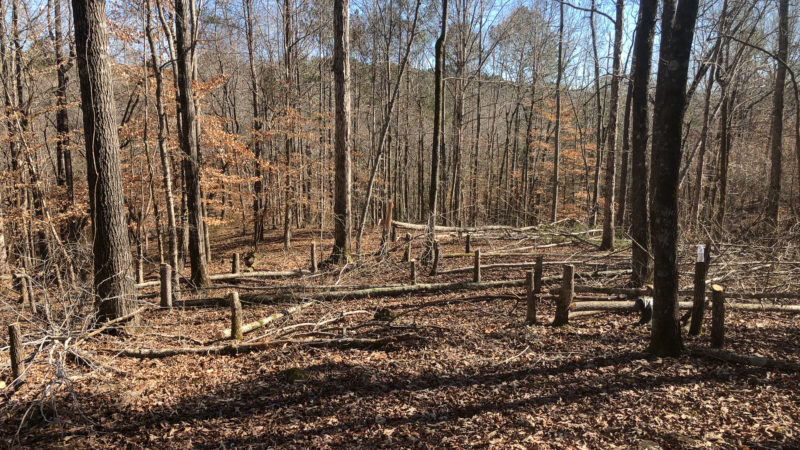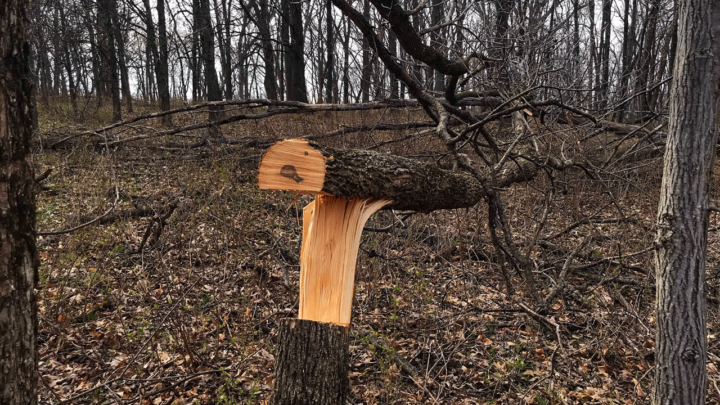Habitat season is here. Improving the dynamics of your woods is no simple task, but it’s an important one if you plan to hold deer, alter movement, or increase browse availability for deer. A few years ago, my father and I wanted to remove some non-desirable trees in an area where we wanted to increase the cover off a main food plot.
We reached out to our nearest state agency forester, and they visited the site, helped mark trees, and gave us a general blueprint of how to go about cutting these areas. Since then, we’ve made progress and are seeing the benefits already.

Before beginning a timber stand Improvement project of any size, it’s important to make a list of goals, acquire knowledge and the proper gear, and take safety measures.
It’s also important to consider treating invasive species before opening the canopy. If you already have invasive plants and shrubs like multi-floral rose or honeysuckle, opening the canopy will only encourage the spread.
You also don’t want to make 60–80-year mistakes by cutting the wrong trees. Here is how to start your TSI project.

Goals
You can certainly go into a TSI project without any goals other than improving the timber quality on your land, after all, it is called Timber Stand Improvement for a reason. When timber goals are not the main priority, the project sometimes gets labeled Forest Stand Improvement since your aim is to improve forest structure and provide age diversity.
Since you’re reading this article, it’s likely you’re a dedicated deer hunter who not only wants to improve timber value by freeing up or “releasing” crop trees like oaks, so they produce more acorns, but you also want to improve your hunting.
The best thing you can do prior to embarking on a TSI project is create a list of goals. Do you only want to improve your land’s timber, create openings in the canopy, or simply improve hunting? Write it down.
If you have never previously been involved in a TSI project, it would be wise to reach out to a private forester or a forester from your state wildlife agency to talk with them about your goals and see if they can visit your property to verify tree species and areas you should cut.
Dwayne Jones is the owner of Dream Dirt LLC habitat consulting and co-owner of Shed Season. He told me, “My suggestion would be to do some research and reach out to your local Farm Service Agency office for guidance. This could include involving a forester to help get you on the right track, or even funding (via programs like EQUIP) to help you hire the work done.”

“If you want to cut a specific area because it’s south-facing or because it’s around the bend from your prime food plot and consists of good deer bedding, tell them this during the visit and keep reminding them what your main goal is throughout the project.”
Jones continued, “The cutting method I prefer largely depends on the application and what I’m trying to accomplish. If I’m trying to improve bedding in an area loaded with small to medium soft wood trees, I will likely do some felling and some hinging to accomplish my goals.”
Equipment
First things first – safety. Cutting trees of any size can be extremely dangerous. As you get into larger trees, they may fall into another and hang up and as you’re working through an area, they may end up falling at any time even though they previously looked stuck on another large tree.
If you’re not trained with a chainsaw, you shouldn’t be intimidated, instead know there are quite a few chainsaw safety classes offered if you do some research.
Your state agency will likely point you in the right direction of a class taught by someone knowledgeable. You should always wear protective chaps, ear and eye protection, and good footwear since many areas where you want deer cover may present uneven terrain.

How to Cut
Understanding what kind of cut or treatment to use that best aligns with your goals is critical for a successful project. Before doing any project, you need to know if you will be completely felling trees, hinge-cutting, using hack and squirt, or girdling.
These are all fine methods, but will they help you accomplish your goals? If you want aspen sapling regeneration to increase browse and bedding, you will want to take down that whole tree with a flush cut to regenerate hundreds of aspen saplings.
Jones said he routinely sees clients implementing ill-advised hinge-cutting because they see or hear about it on social media and think it will be a great improvement for their land. He said, “hinge cutting has become a buzzword in the whitetail space, and I think it is far overused.”
Jones continued, “When doing a TSI project for whitetail habitat, you are trying to do a few things. First, is adding horizontal cover, opening up the canopy to allow regenerative growth, and ‘releasing’ desirable trees like oaks to produce more acorns. Hinge cutting only does one of those, and it actually inhibits the other two. While it does have its place, I feel it is overused.”

“If you want large holes in the canopy to create pockets of cover, you’ll want to flush cut, girdle, or hack and squirt to completely kill the tree to allow sunlight to reach the ground. I usually air on the side of completely felling most trees I intend to kill unless they are too large for safety reasons.”
While felling trees, Jones usually has a goal in mind of opening large holes in the canopy or cutting an inferior tree to provide sunlight to a superior one. He told me, “If I’m trying to crop tree release a stand of white oaks, I will usually use the girdle technique. This will keep me from having to completely cut down a bunch of large trees which will save me time and keep me safer.”
He said a lot of people underestimate how many trees you need to cut down to allow significant sunshine to reach the forest floor. Jones said, “Many times, folks are nervous about cutting down too much and making it look messy. So, they only cut 25% of what is actually needed, and then don’t get the growth response they hoped for.”

Another way to take out large trees is by using the hack and squirt method. It is safe and still effective when tree sap isn’t flowing in sap-heavy trees like maples. The Craig Harper cocktail is a great start. Hinge cutting can be a good way to screen off certain areas, provide horizontal cover that Jones mentioned, and redirect travel.
Keep in mind, it isn’t pretty to look at and can create a lot of re-work if forest aesthetics means something to you, or a co-owner of your property. Remember though, great deer habitat is usually messy with lots of edge and isn’t always easy on the eye, which is why deer like it.

When completely felling trees, you want to drop trees into the openings you’ve already made so they don’t hang up in other trees. If you’re in hill country, you want to start cutting low and work your way uphill.
Look at “leaner” trees for a second and be sure the tree isn’t going to start falling and pinch the blade of your chainsaw. Creating notches on the backside of trees or notching them where you want them to fall also helps. Be sure to bring along a wedge and sledgehammer in case your blade gets stuck.
Sixty-Year Mistakes
I mentioned this earlier, but it’s worth a dedicated section. It can’t be overstated how important it is to know what you’re cutting! This is especially true if the land you manage is in trust or shared with other family members who benefit financially from timber logging.
Oaks are relatively easy to identify, but other high-value trees like walnut and certain species of maple are sometimes more difficult to identify.
Depending on what stage of growth a high value tree is in, one tree alone could be worth $1,000 or more. Jones said, “It takes very little time to become familiar with the desirable tree species, but it takes them a long time to grow back if you go in and make the mistake of cutting down the wrong trees.”
If you aren’t great with tree identification, consult an expert and have them mark trees to cut for you. If it isn’t free for a forester to walk the land with you, cost sharing for habitat improvement projects is sometimes available through your state wildlife agency or local NRCS branch.

What About Logging?
If you aren’t interested in a TSI project because you are due to have your property logged, I would highly recommend doing your research and asking lots of questions from people experienced with logging. Acquire multiple bids from different companies because they will likely differ.
There are horror stories of unsupervised logging projects costing landowners thousands of dollars. My intention isn’t to create a bad name for the logging industry, but you need to research and have someone carefully watch the entirety of the project to ensure your timber and financial goals equate at the end.

To start, you should research both private foresters and your state agency foresters. They will begin pointing you in the right direction of reputable logging companies. Ask for references from the companies and find online recommendations.
Logging can be great income and an excellent way to improve deer habitat through large openings created in the canopy. If you have a lot of oaks, ask about waiting to harvest on a big acorn year. Cutting down oaks holding acorns will scatter acorns all over the woods. Have them leave the treetops so new oaks can hide from deer within the tops and grow. Then, follow up by shooting more does than normal in an attempt to regenerate more oaks.
Conclusion
Taking on a TSI project can seem intimidating, but you’ll be amazed at the power of a chainsaw and what it can do for deer habitat in such a short period of time.
Keep your goals in the forefront of your mind, do your research, and ask questions from experts you’ve connected with throughout the process.
Watch the video below for a look at how Todd Graf is making major moves to improve the long-term impact of timber on his dream hunting farm.

 By
By 



